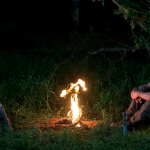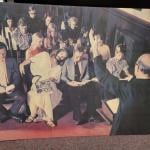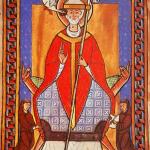Readers, please raise your (virtual) hand if you have ever heard 1 Peter 3:15 (the one about being prepared to give a defense for the hope that is in you) used to justify why you need to have a “testimony” or pat story about your conversion, ready to be shared at the drop of a hat. Though I believe that both apologetics and personal storytelling are necessary to Christian faith, I also get frustrated with the assumption that your faith-story is supposed to be always the same, no matter to whom or in what circumstances it’s told. Add to that the all-too-common pressure to make sure your story conforms to a preset pattern, and you can begin to understand the difficulty of how a contemporary writer could craft a spiritual autobiography as deep, meaningful, or distinctive as those of Augustine or Teresa of Ávila.
Carlene Bauer, author of Not That Kind of Girl: A Memoir, openly struggles against the stereotypical evangelical narrative as she tries to tell her own story of faith and doubt. Bauer, whose mother took her to a non-denominational evangelical church, writes of her growing frustration, in her teenage years, with the way that the evangelical narrative treats certain kinds of experience: “It described pain and suffering in such a way that a person might think alcoholism or the loss of a child were no more inconvenient than a tussle with the flu: after it passed, you could stand in front of the congregation on Sunday and testify that it was all better, and God was good.” Bauer continues, “As far as I could tell, that was the only story told by the official soul, and real and true sadnesses had been excised for a more mellifluous account.”
So far, so good. I can identify with Bauer’s frustration. However, what seems missing in this passage—and in the structure of her own narrative—is the understanding that all narratives make excisions, for one reason or another. That’s why they’re narratives, and not phone books. Bauer seems so intent upon making sure that her own story doesn’t follow the set pattern of an evangelical conversion narrative that she jettisons coherence. To her credit (sort of), I understand that this is intentional: the story that she wishes to tell is of moving from a position of certainty to a position of uncertainty (and a rather triumphant uncertainty at that). Therefore, it makes sense for her story to lack any clear trajectory, except the one of not knowing where she’s going.
To give you an idea of Bauer’s story’s destination, here’s a passage from the penultimate page of the memoir. Bauer is listening to a man on the subway preaching repentance from sin, and she reflects:
“I prefer not to know anything. . . . Thinking you know anything makes it impossible to say that God is light. It makes Korean cabdrivers tell me they think God sent a tsunami to Indonesia because it is a country of Muslim infidels. It makes voters convinced that legalizing gay marriage will result in domestic partnerships between dogs and humans. It makes young Muslim men think their sisters’ sexuality is poison, and stone them because of it. I prefer novels. For the same reason I prefer this city. Both teem with particulars and offer no one truth.”
But did you notice something there? Bauer may have broken out of the evangelical narrative, but she’s fallen for the secular postmodern narrative of “certainty equals intolerance, and intolerance is bad.” We are narrative creatures, and I don’t think it’s possible to be entirely free from seeing our lives according to some pre-existing story (or “metanarrative,” as literary theorists like to say). The key is to pick a good story. (And here, if I weren’t already making this too long, I would quote a novel teeming with particulars that also offers truth: the great passage from The Lord of the Rings where Frodo and Sam discuss the nature of stories. It’s in Chapter 8 of The Two Towers. Go read it. You know you want to.)
To tell a good story, to know what larger narrative you should attach your own life to, it helps to have a community—and this is an element that Bauer herself claims is missing in her life. We never really get a clear sense—perhaps because the author herself isn’t sure—of why Bauer’s mother suddenly becomes more concerned about matters of faith and begins taking her daughters to an evangelical church. In the author’s summary of her high school, college, and early professional years in New Jersey, Baltimore, and New York City, we hear a lot of friends’ names, but they get confusing, because we’re not really sure why we should—or even if the author does—care about them.
This lack of community in the memoir is one reason I got so excited when Bauer reports a scene of herself discovering a quote from Iris Murdoch: “Love is the extremely uncomfortable realization that something other than oneself is real.” Yes, please! More of that kind of story! It’s actually after finding this passage that the author (according to this particular, excised version of her narrative, anyway) begins to attend mass at a Catholic church in New York City. Bauer even goes as far as going through the formal process of RCIA and officially becoming Catholic. However, she rather mysteriously loses interest in Catholicism—and Christianity altogether—after 9/11. I say “mysteriously” not because the experience of massive pain and suffering and death doesn’t shake one’s faith—of course it does—but Bauer never really explains why her own story of faith can’t make room for a God who would allow such suffering to happen. Her narrative begins to seem not so different from the evangelical testimonies she objects to earlier in the memoir: in either kind of story, there’s no room for suffering and God’s goodness to coexist together.
It’s odd that a writer like Bauer, who references St. John of the Cross’s The Dark Night of the Soul and Dorothy Day’s The Long Loneliness, should reach such a conclusion. Obviously these writers, among other Christians throughout the centuries, have found a story—and a slightly different story for each—that tells God’s goodness without ignoring suffering. If Bauer, while admiring these writers, came to reject their stories, I want to know why. Sadly, the memoir is too busy recounting the author’s various crushes to deal with this question.
For the orthodox Christian spiritual autobiography, there really is only one narrative—“I am a great sinner and Christ is a great Savior,” as John Newton put it—but that old story can be told in ways that make it seem fresh and at least somewhat individual. Two contemporary writers who have done so with great success are Kathleen Norris and Anne Lamott, both of whom make the telling interesting by breaking away from the linear pre-conversion—conversion—post-conversion pattern. Bauer, on the other hand, tries to tell a de-conversion story, but her linear reporting of events, without any greater story sorting out those events, makes the narrative feel more like that phone book I mentioned earlier. It’s full of particulars, all right, but little to help the reader care about those particulars. The effect, in Bauer’s narrative, is to put her succession of religious experiments on the same level as her succession of boyfriends. And I’m just not the kind of girl who finds that story interesting.
(Note: I received a free review copy, on behalf of Christ and Pop Culture, of Not That Kind of Girl.)















